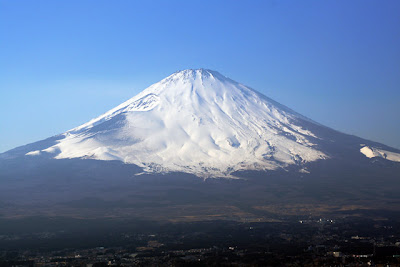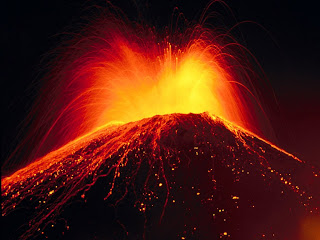Landslides are common on volcanoes because their massive cones (1) typically rise hundreds to thousands of meters above the surrounding terrain; and (2) are often weakened by the very process that created them--the rise and eruption of molten rock. Each time magma moves toward the surface, overlying rocks are shouldered aside as the molten rock makes room for itself, often creating internal shear zones or oversteepening one or more sides of the cone. Magma that remains within the cone releases volcanic gases that partially dissolve in groundwater, resulting in a hot acidic hydrothermal system that weakens rock by altering rock minerals to clay. Furthermore, the tremendous mass of thousands of layers lava and loose fragmented rock debris can lead to internal faults and fault zones that move frequently as the cone "settles" under the downward pull of gravity.
 A scientist stands on one of the many small hills that form the chaotic surface of a massive landslide deposit in the upper North Fork Toutle River valley below Mount St. Helens volcano (10 km in distance). Before the landslide and eruption on May 18, 1980, a forest grew on this part of the valley floor, and a highway followed the meandering river to Spirit Lake, a popular recreation area.
A scientist stands on one of the many small hills that form the chaotic surface of a massive landslide deposit in the upper North Fork Toutle River valley below Mount St. Helens volcano (10 km in distance). Before the landslide and eruption on May 18, 1980, a forest grew on this part of the valley floor, and a highway followed the meandering river to Spirit Lake, a popular recreation area.  Lahar produced as a result of an eruption by Mt. St Helens
Lahar produced as a result of an eruption by Mt. St HelensSource: http://www.geology.sdsu.edu/how_volcanoes_work/Images/lahars/laharmsh_l.jpg
Some lahars contain so much rock debris (60 to 90% by weight) that they look like fast-moving rivers of wet concrete. Close to their source, these flows are powerful enough to rip up and carry trees, houses, and huge boulders miles downstream. Farther downstream they entomb everything in their path in mud.
Eruptions may trigger one or more lahars directly by quickly melting snow and ice on a volcano or ejecting water from a crater lake. More often, lahars are formed by intense rainfall during or after an eruption--rainwater can easily erode loose volcanic rock and soil on hillsides and in river valleys
Lahars almost always occur on or near stratovolcanoes because these volcanoes tend to erupt explosively and their tall, steep cones are either snow covered, topped with a crater lake, constructed of weakly consolidated rock debris that is easily eroded, or internally weakened by hot hydrothermal fluids.
Tsunami
Tsunamis are giant sea waves that form when volcanoes erupt in or near large bodies of water, and are a secondary hazard of eruptions, especially very violent caldera-forming events. Volcanic tsunami can be generate in a number of ways, including the eruption of a submarine volcano, the inward collapse of a volcano during or after an eruption, the flow of volcanic debris down the side of a volcano into the sea, large earthquakes associated with the volcano, or by boiling or expelling water out of a hot, collapsed crater.
Volcanic Tremors and Earthquakes
Seismicity is another common accompaniment of volcanic activity. Eruptions are commonly preceded by local earthquakes, which may be caused by the cracking and splitting open of fissures as the magmas chamber inflates. There are three general categories of earthquakes that can occur at a volcano: volcano-tectonic earthquakes, long period earthquakes and volcanic or harmonic tremors.
Volcano-tectonic earthquakes are earthquakes produced by stress changes in solid rock due to the injection or withdrawal of magma (molten rock). These earthquakes can cause land to subside and can produce large ground cracks. These earthquakes can occur as rock is moving to fill in spaces where magma is no longer present.
Long period earthquakes are produced by the injection of magma into the surrounding rock. These earthquakes are a result of pressure changes during the unsteady transport of the magma. When magma injection is sustained, a lot of earthquakes are produced. This kind of earthquakes can be used to predict future occurrences of volcanic eruptions.
Harmonic tremors largely consist of a more or less continuous, low frequency, rhythmic ground motion. It may be associated with actual movement of magma.
Next: Impact of Volcanic Hazards on DCs and LDCs.


































